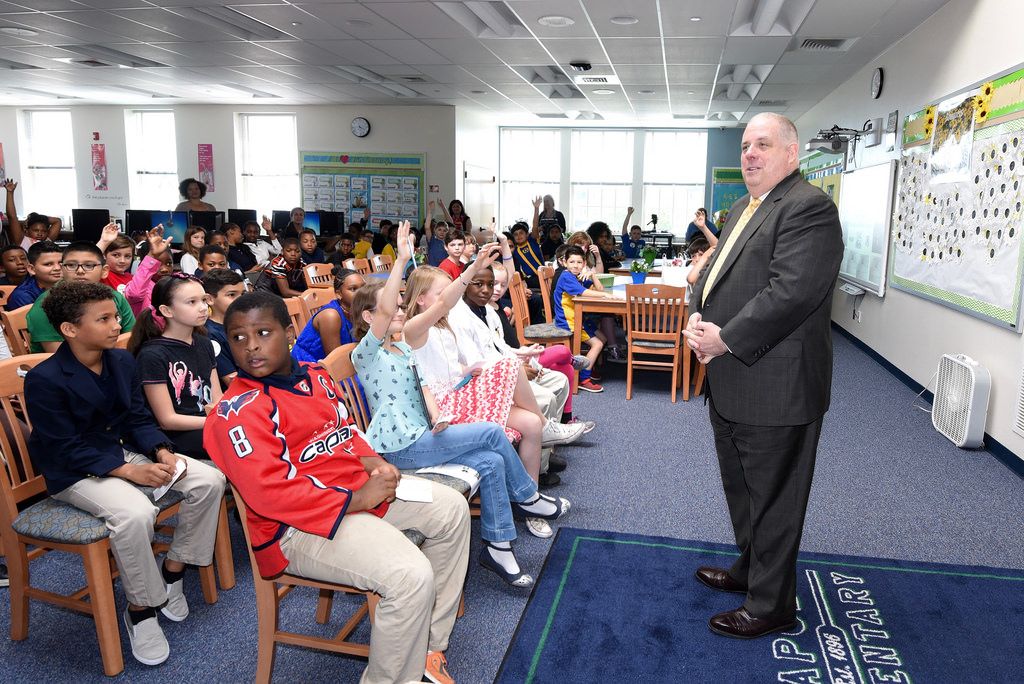Views expressed in opinion columns are the author’s own.
In his State of the State Address, Maryland Gov. Larry Hogan launched the 2019 legislative session and introduced his 2020 budget with his usual proclamations of “record investment in K-12 education” and “fiscal responsibility.” Campaign ads and social media posts laud Hogan for miraculously managing to fund education without raising taxes or increasing the deficit. His commitment to education, supporters say, is why he soared to victory as a Republican in a deeply blue state. But a closer look at Hogan’s budget proves he is failing to give our public schools the substantial investment they truly need.
Hogan’s 2020 budget includes $6.9 billion in school funding, above what’s mandated by state aid formulas currently in use. But that increase isn’t noteworthy: State spending on education has increased every year since at least 2003. In fact, in his first term, Hogan actually increased education spending at a lower rate than his predecessors — a mere 7.8 percent, compared with 44 percent for Bob Ehrlich and 28 percent for Martin O’Malley in their first terms. Such a marginal increase in spending has done little to alleviate the opportunity gap that persists in Maryland between high- and low-income students.
That’s where the Kirwan Commission comes in. The commission was tasked with reviewing the current state of Maryland schools and coming up with specific recommendations to improve educational outcomes, especially for the state’s most vulnerable students and schools. Last year, the commission recommended an increase of $3.8 billion phased in over 10 years, with a $325 million increase for the 2020 fiscal year. That money would be used to fund pre-kindergarten, pay increases for teachers, school-based health centers and other interventions in the form of staffing and programming using money that would come out of the operating budget.
Instead of fully funding the commission’s recommendations, Hogan allocated only $200 million out of the proposed $325 million. Though he did agree to raise state employee wages by 3 percent, Hogan ignored calls from union organizers at AFSCME to raise wages by 5 percent to keep up with inflation. Instead, he prioritized school construction funding, which is vital, but not enough.
It’s been obvious for years that Baltimore City and Kent County schools need buildings with heat and AC. It’s clear buildings across the state are dilapidated, crumbling and dangerous to students. We should not shower praise upon Hogan for providing only the most basic of needs in 2019.
Even the governor’s school construction proposals are not as wondrous as he would make them seem. Instead of fully funding public schools, he’s siphoning off specific funding for charter schools and expanding state funding for vouchers for parents to send their children to private schools, with his 2020 budget set to include nearly $4 million toward charter construction and repairs. Charter schools have an exclusionary history, and don’t serve Maryland students equitably. They divert resources away from public schools and limit the state’s ability to hold schools accountable.
Inadequate state investment in public education leads to underpaid teachers and overworked staff, not to mention first-generation students who are unable to pay the rising cost of tuition and housing. And when schools are unable to afford copy paper and pencils, administrators are forced to seek donations from private donors and entities, who seek disproportionate control over our schools without adequate accountability.
Instead of praising Hogan, let’s hold him and his administration accountable and demand that he fully fund our public schools. Our students deserve nothing less.
Olivia Delaplaine is a senior government and politics major. She can be reached at odelaplaine15@gmail.com.
CORRECTION: Due to a columnist error, a previous version of this column misstated Gov. Hogan’s education spending. The Maryland state budget will provide for $6.9 billion in education spending, not a $6.9 billion increase in education spending. This column has been updated.



